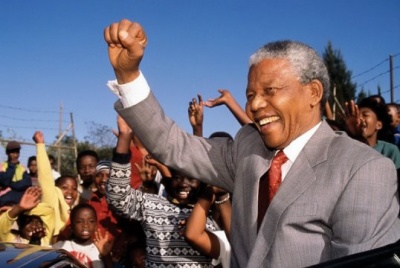Difference between revisions of "The South African Peace Accord"
| Line 1: | Line 1: | ||
=== 14 September, 1991 === | === 14 September, 1991 === | ||
[[File:14September1991.jpg|400px|thumbnail|left]] | [[File:14September1991.jpg|400px|thumbnail|left]] | ||
| − | In 1989, one year before Nelson Mandela was released from prison, South Africa endured brutal political violence as over 1,400 people were killed in political protests. Many South Africans felt that Mandela?s release would be seen as a sign of stability and unity. However, after Mandela?s release in 1990, political violence and killings increased by 163 percent. With the rise of violence and the failure of multiple attempts by the government to quell the violence, it was realised that a new approach was needed by [[Civil Society|civil society]], political and private enterprises, as well as the international community. On 22 June, 1991, South Africa organised a think tank project, which brought together politicians from a range of diverse political parties. The event was a great success as it established a code of conduct for political parties and security forces; socioeconomic development; implementation and monitoring; and process, the secretariat, and media. On 14 September, 1991, the South African Peace Accord was signed by various key South African figures, helping to pave the way for a peaceful and united South Africa. | + | In 1989, one year before [[Mandela, Nelson|Nelson Mandela]] was released from prison, South Africa endured brutal political violence as over 1,400 people were killed in political protests. Many South Africans felt that Mandela?s release would be seen as a sign of stability and unity. However, after Mandela?s release in 1990, political violence and killings increased by 163 percent. With the rise of violence and the failure of multiple attempts by the government to quell the violence, it was realised that a new approach was needed by [[Civil Society|civil society]], political and private enterprises, as well as the international community. On 22 June, 1991, South Africa organised a think tank project, which brought together politicians from a range of diverse political parties. The event was a great success as it established a code of conduct for political parties and security forces; socioeconomic development; implementation and monitoring; and process, the secretariat, and media. On 14 September, 1991, the South African Peace Accord was signed by various key South African figures, helping to pave the way for a peaceful and united South Africa. |
[[Category:Peacebuilding and Reconciliation]] | [[Category:Peacebuilding and Reconciliation]] | ||
Latest revision as of 09:51, 1 April 2014
14 September, 1991[edit]
In 1989, one year before Nelson Mandela was released from prison, South Africa endured brutal political violence as over 1,400 people were killed in political protests. Many South Africans felt that Mandela?s release would be seen as a sign of stability and unity. However, after Mandela?s release in 1990, political violence and killings increased by 163 percent. With the rise of violence and the failure of multiple attempts by the government to quell the violence, it was realised that a new approach was needed by civil society, political and private enterprises, as well as the international community. On 22 June, 1991, South Africa organised a think tank project, which brought together politicians from a range of diverse political parties. The event was a great success as it established a code of conduct for political parties and security forces; socioeconomic development; implementation and monitoring; and process, the secretariat, and media. On 14 September, 1991, the South African Peace Accord was signed by various key South African figures, helping to pave the way for a peaceful and united South Africa.
